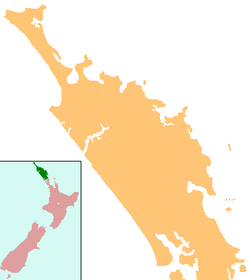Matakohe
| Matakohe | |
|---|---|
| Coordinates: 36°7′46″S 174°11′6″E / 36.12944°S 174.18500°ECoordinates: 36°7′46″S 174°11′6″E / 36.12944°S 174.18500°E | |
| Country | New Zealand |
| Region | Northland Region |
| District | Kaipara District |
| Population (2006) | |
| • Total | 400 |
Matakohe is a settlement in Northland, New Zealand. The Matakohe River is a short river which runs from the north into the Arapaoa River, which is part of the Kaipara Harbour. State Highway 12 passes through Matakohe. Ruawai is 16 km to the west, and Paparoa is 6 km north east. The Hukatere Peninsula extends south into the Kaipara Harbour.
The Kauri Museum at Matakohe shows the area's heritage in the kauri timber industry.
The current population is approximately 400.
The Matakohe block was first settled by Pakeha in 1863, when members of the Albertland religious group arrived in New Zealand. The land was initially burnt off to allow for the planting of crops and grass. A weekly (initially monthly) ferry service brought mail, and a road was constructed to Paparoa. In 1881, the longest wharf in the Kaipara—1,450 feet (440 m) long—was built at Matakohe to accommodate the steamers. Minnie Casey served Matakohe in the 1880s, and the S.S. Ethel, then the S.S. Tangihua in the 1890s.
The kauri gum industry became established around Matakohe in 1867-70, possibly the first place in the Kaipara District that the industry developed amongst settlers. A flax mill was built in 1870, but it was not profitable and was soon converted to a timber mill. This was replaced by a larger timber mill in the 1880s. The mill was destroyed by fire in 1906. Matakohe held a race-day each February, in which were entries from as far as Kaiwaka and Waipu.
In the 1890s, the population of Matakohe increased from 93 to 231, and the town was described as "the principal place in the Otamatea County". By 1902 the town had two boarding houses, a library, stores and a goods shed, as well as the older church and school. The population reached 264 in 1906, but declined to 141 in 1921.
Focus shifted to dairy farming in the early 20th century. Apple growing was also successful at first, but ceased by 1935 due to the Great Depression and poor management. The roads improved, and by 1920 all 53 miles (85 km) of roads in the area were metalled, using the abundant local supplies of limestone. The route to Dargaville was improved by the opening of a road through Ruawai in 1927, replacing the inland road.
...
Wikipedia

